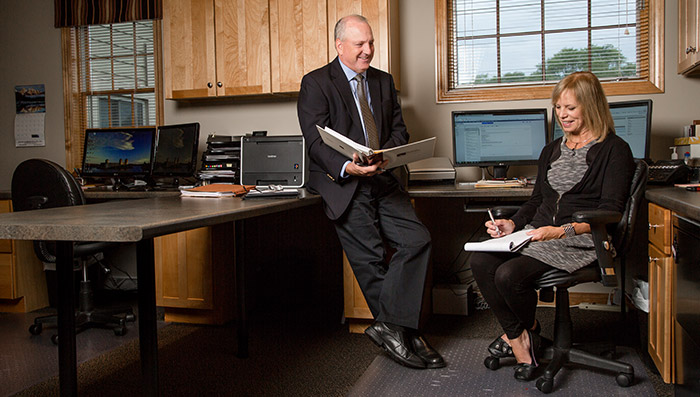The two-way street of risk and return
The two-way street of risk and return

James Franke • Milwaukee, Wisconsin
Franke Martens Group • Harbour Investments, Inc.
Striking the delicate balance between protecting client assets and generating growth is at the core of his active management approach.
Proactive Advisor Magazine: Jim, how would you describe your client service philosophy?
I started in the industry on the insurance side and pretty rapidly progressed as a full-service financial planner and investment advisor. I was one of the relatively early recipients of the American College’s Chartered Financial Consultant designation and also am a Chartered Life Underwriter.
I think the insurance background established my philosophy on how to deal with clients and the fact that it is really a two-way street. To survive and prosper in this business, you have to be client-oriented. Helping people get to where they want to go will help you build a business with a strong and enduring foundation.

In expanding your expertise from insurance to the advisory side, how did you develop an investment style for clients?
In the 1990s, the markets were doing great, and the traditional theories of portfolio allocation were working pretty flawlessly for clients. Since then, the fundamental change in the nature of markets, globalization, and the access to data has really altered all of the old models. Risk management, which was usually confined to the limited abilities of those allocation models, has taken on a whole new perspective and emphasis given the severe market corrections we have seen since 2000.
The nature of my client base has also affected how I think about risk. The majority of my clients have more or less matured along with me and have a very different outlook as they think about or enter into retirement. They are not willing to subject their lifelong building of assets to the whims of the stock market. Their first priority is to protect what they have, and the growth of assets is a close second. They are very receptive to new ways of thinking about investment strategies.
Please explain.
First, I talk about the old way—and I do that with clients all of the time. Many people have the misunderstanding that mutual funds are somehow structured to help protect against market downturns or have the ability to go to cash in a significant way. Mutual funds tend to market themselves as being “actively managed.” But that is very misleading, as they really are just managed against the objective or benchmark of that particular fund, typically staying close to fully invested. This historically has created a lot of confusion for individual investors and certainly does not help when the entire market goes down.
I think 2008 was the last straw for a lot of people. Many of my clients and prospects are fearful about the equity markets. It is my job to discuss and understand their goals, aspirations, and financial needs as they try and build toward their specific life objectives. It is also my responsibility to understand their risk profile within that framework—and I often dig deeper than most risk questionnaires. What were their real thoughts, emotions, and fears during the market meltdown? How can we help them overcome their obstacles—whether financial or behavioral?
This leads to a discussion of active money management. Some clients have a natural inclination toward being very conservative with their investments—it is hard to blame them. But when I describe an active investment approach that is geared toward protecting downside risk while taking advantage of market returns, they become very receptive to the message.
Where does this fit in with your overall financial-planning approach?
 I tend to use a “bucket” approach to segment, or earmark, assets depending on the individual’s or couple’s specific objectives. A lot of clients want the assurance of a guaranteed stream of income entering retirement, for which we use an annuity or other insurance product. But here’s the interesting paradox if a client is extremely conservative: there is an even bigger risk of not generating enough asset growth to fully fund their retirement. It can be a delicate balance for many people.
I tend to use a “bucket” approach to segment, or earmark, assets depending on the individual’s or couple’s specific objectives. A lot of clients want the assurance of a guaranteed stream of income entering retirement, for which we use an annuity or other insurance product. But here’s the interesting paradox if a client is extremely conservative: there is an even bigger risk of not generating enough asset growth to fully fund their retirement. It can be a delicate balance for many people.
This is where explaining an actively managed investment approach can help. To use a broad example, a client with a fairly conservative outlook may have a portion of their assets in a guaranteed product to ensure a consistent income stream. But they may also have a portion in an actively managed portfolio, which can be geared very specifically to their risk profile and help with their longer-term asset growth.
There is another benefit to our more holistic approach to active management that most people do not realize—and that is the degree to which we can have actively managed portfolios along the risk spectrum. Even the most conservative clients can allocate some of their money in equity markets in a very risk-controlled fashion. And for the very aggressive investor, there are strategies that may be leveraged, while still staying in tune with market conditions. For most every client, we find the right balance of comfort that still meets their overall planning needs.
When I am asked whether active strategies can achieve market returns in a strong bull market, the answer is yes—depending on the amount of risk you are willing to assume. Those strategies designed to deliver market returns will generally do so, but that obviously introduces a higher level of volatility. Still, even with more aggressive strategies, the working principle is that they should be able to avoid the largest market drawdowns, or even profit in bearish market conditions if a trend is clearly identified.
What is the biggest challenge you face with clients?
I touched upon the issue of fear or nervousness about the markets, but I think with our active management approach we have come a long way in addressing that. The other issue is the explosion of information that is readily available to everyone about financial issues, investing, and retirement planning. On the one hand, it is certainly a good thing to have more informed clients. However, it has also led to people viewing things as overly complicated and confusing. There are so many voices out there—good and bad information.
One of my personal goals for clients is simplification and organization. That may take a fair amount of work upfront, but it really pays off in the long run. I like to think our firm is very good at client education, and our goal is helping people realize how to best utilize their financial resources to create a positive impact on their quality of life.
Disclosure: James Franke is an investment advisor representative offering securities and advisory services through Harbour Investments, Inc., member FINRA/SIPC. Franke Martens Group is independent of Harbour Investments, Inc.
Photography by Sara Stathas

